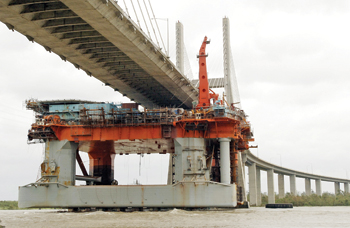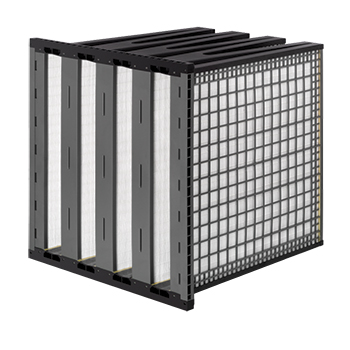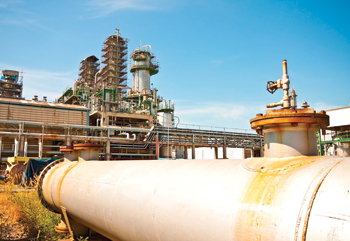
 Effective management of corrosion is the key to reduction in deferment costs
Effective management of corrosion is the key to reduction in deferment costs
THE TOTAL annual cost of corrosion in the oil and gas production industry is estimated to be $1.37 billion, broken down into $589 million in surface pipeline and facility costs, $463 million annually in downhole tubing expenses, and another $320 million in capital expenditures related to corrosion, according to Nace.
It is widely recognised within the oil and gas industry that effective management of corrosion will contribute towards achieving the following benefits: statutory or corporate compliance with safety, health and environmental policies; reduction in leaks; increased plant availability; reduction in unplanned maintenance; and reduction in deferment costs.
Meanwhile, the global corrosion inhibitors market is expected to reach $7.55 billion by 2020, according to a new study by Grand View Research. Power generation was the largest end-use industry for corrosion inhibitors, with market demand of 1,366.5 kilo tonnes in 2013. Increasing power generation in China, India and Middle East coupled with growing instances of corrosion in cooling towers, steam and hydropower turbines is expected to augment demand. The oil and gas industry is also expected to witness significant rise in corrosion inhibitor demand growing at a CAGR of 5.6 per cent from 2014 to 2020.
Corrosion inhibitors form an important part of the water treatment chemicals market and growing regulatory pressure for water treatment is expected to boost market demand. Corrosion inhibitors are also used in the construction industry as part of preventive maintenance for metallic structures. Mexico, China, Brazil and India are expected to witness exponential rise in infrastructure and construction, which is expected to augment demand for corrosion inhibitors.
Further key findings from the study suggest:
Global corrosion inhibitors market demand was 4,659.8 kilo tonnes in 2013 and is expected to reach 6,340.7 kilo tonnes by 2020, growing at a CAGR of 4.5 per cent from 2014 to 2020.
Water-based corrosion inhibitors dominated the market in 2013 accounting for over 70 per cent of global demand. These applications are preferred over their solvent based counterparts as they have lower VOC emissions which make them environmentally beneficial. Organic corrosion inhibitors were the most widely used product with demand exceeding 3,300 kilo tonnes in 2013. They are preferred over inorganic inhibitors as they are non-toxic making them feasible for use in water treatment and paint and coating industry.
Asia Pacific was the largest market for corrosion inhibitors, accounting for 38.78 per cent of market volume in 2013. Industrial growth in automobile, chemicals and oil and gas sector is expected to boost the demand for corrosion inhibitor in the region.
The global corrosion inhibitors market is fragmented with the top four companies accounting for less than 40 per cent of global market in 2013. Key companies include BASF, Ashland, Ecolab, GE Water, DuPont, Dow Chemicals Company, Champion Technologies, Cytec, and Lubrizol Corporation.
Meanwhile, protective coatings market is expected to witness growth owing to increased concerns towards thermal stability, durability, fire and corrosion resistance in oil and gas, construction, manufacturing and automotive industry.
Gaining popularity of water borne and eco-friendly coatings is expected to have a positive impact on market growth. European Commission’s paints directive 2004/42/EC for limiting VOC emission, is expected to play an important role in promoting eco-friendly products demand such as powder coatings over the forecast period.
Automotive industry growth in Brazil, Mexico, China and Malaysia is expected to have a positive impact on protective coatings market. Increased government funding towards improving infrastructure is expected to fuel protective coatings demand in construction and architectural applications in the near future.
Increasing petroleum production in Brazil and China coupled with growing preference towards preventive maintenance is expected to promote protective coatings use in oil and gas sector. Oman Oil Company and Sabic have announced establishment of petrochemical production facilities, which are further expected to positively impact market growth.
Key market participants such as PPG Industries, BASF, AkzoNobel and Dow are focusing on new product developments. In 2013, BASF launched Relest Powder PUR Anti-Sticker coating, with a property of anti-sticking surface protection. Application growth in construction, automotive and oil and gas industry in Asia Pacific has resulted in protective coatings market players setting up manufacturing facilities in the region.
AkzoNobel and Axalta announced construction of new production facility for powder coatings in China. Indian government’s PCPIR policy intended for promoting chemical production is expected to open new avenues for protective coatings over the forecast period.





































































